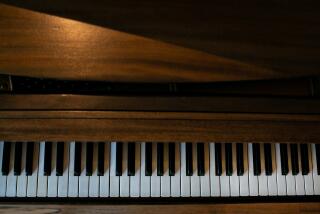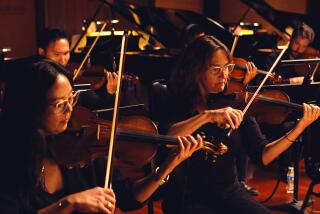Attuned to the Computer : An array of instructional programs for the home system can awaken young talent and even introduce a skill or two.
- Share via
You love music, you want your kids to love music. But it’s too early for music lessons. Can your home computer fill in the gap? Can it awaken some early musical talent, maybe even introduce a skill or two?
It can.
Particularly if it’s running a well-thought-out piece of home computer software like Broderbund Software’s “The Treehouse.” This early learning package (for 6- to 10-year-olds) helps kids explore music through three engaging games.
The first plays pre-programmed songs on a wide array of musical instruments (including the duck and the chicken, along with many legitimate ones) while illustrating the melodies on a musical staff and a piano keyboard. Kids can connect the sounds they hear with the way they’re notated and played. On the same screen they can compose their own melodies, save the songs and hear (and see) them played back by all the instruments.
For a break from composing, there’s a delightful maze game that teaches pitch and timing, and an orchestra pit offering brief lessons about various musical instruments.
Besides its musical games, “The Treehouse” package contains ingenious games in math, spelling, animals and theater. At $59.95, “The Treehouse” gives full value in music and more.
“MetroGnomes’ Music” by the Learning Co., which produces the popular “Reader Rabbit” series) is a dedicated music program for the very youngest PC users (the box says ages 4 to 7, but my 7-year-old takes one look at the graphics and sniffs “Natalie’s game”--her 4-year-old sister’s, that is). It includes a library of simple tunes, a pitch-training game, a tempo trainer and a screen for composing a melody where kids can listen to their tunes played by different instruments.
The sounds and animation are charming and will engage the very youngest of mouse-clickers. A drawback: The learning range is so narrow that most tykes will master its skills almost as soon as their brains are ready to understand them.
A new way for kids to have fun playing around with music doesn’t require a PC at all. SuperNintendo has entered the “edutainment” market. Its first entry is the creativity game “Mario Paint and Mouse,” which turns your TV into a place to compose songs, draw pictures and then animate the pictures to go with the songs.
A hilarious set of sounds (cats, dogs, ducks and general cartoon noises at various pitches) waits above a generously long scrolling staff. Welcome to the world of silly sound notation! After your child has filled in the staff, Mario plays the tune back with a jaunty, calypso-like beat. Presto! Instantaneous musical gratification.
The hard work comes later, when kids try to animate their drawings to the music. (All these programs, by the way, require at least initial parent participation.) The program’s 256 RAM memory lets youngsters save their music/animation collages, which can be transferred to video and permanently viewed on VCR.
“Mario Paint and Mouse’s” three principles of music exploration are pleasure, pleasure and pleasure--with discipline running a distant fourth. It makes no attempt, for example, to build notation skills by introducing concepts like sharps/flats and long notes/short notes, as “The Treehouse” does.
On the other hand, “MPM” has one enormous advantage over the PC software: Its physical setup promotes teamwork. The big-screen Nintendo graphics tend to push you away from the TV screen. My Nintendo mouse ended up at a bar in my den, six feet away from the TV screen. Anyone toying with “Mario” tended to be joined sooner or later by someone else walking by.
Eventually two people would be sitting side by side, in equal relationship to the screen, writing in tandem. Unintentionally, Nintendo tapped into a communal spirit at the heart of music-making.
That kind of happy spontaneity is impossible with most PC setups, which place user No. 1 two feet from the monitor or closer. Even when someone gets curious and joins her, they tend to sit behind, and both jockey for a view. The feeling is neither open nor communal.
Which music program is best for your child? It depends on your philosophy of learning. It also depends on your hardware. If you don’t already own a PC with a sound card, go for “Mario.” The SuperNintendo hardware costs only $139.99, and “Mario Paint and Mouse” is $59.95. More educational software for the Nintendo platform is on the way, similarly priced.
Sound Software for Kids
The Treehouse Broderbund Software, for ages 6 to 10, $59.95. Runs on: IBM/Tandy and 100% compatible. VGA/MCGA/EGA and Tandy 16-color. MS/PC-DOS 3.0 or higher. Adlib, SoundBlaster/Pro, Thunder Board and Pro Audio Spectrum/16. 640K RAM hard disk required. Macintosh, Mac/SE/Classic/LC/II series/Performa series color and B & W System 6.07 or above 2MB RAM hard disk required. Apple: IIe/IIc/IIGS, color and monochrome, 128K RAM, ProDos 1.7 or higher.
MetroGnomes’ Music, the Learning Co., for ages 4 to 7, $49.95. Runs on: IBM PC and compatibles with 512K. Tandy 1000 family with 640K. With 3.5” or 5.25” drive, DOS 2.0 or higher. Color monitor: 16-color VGA, 16-color MCGA, 16-color EGA, 16-color TGA, or 4-color CGA graphics adapter. Optional: Hard disk with 720K free. Mouse. AdLib or SoundBlaster sound card.
Mario Paint and Mouse, Nintendo of America Inc., no age specified, $59.95. Runs on: SuperNintendo game format. Includes mouse controller.
More to Read
The biggest entertainment stories
Get our big stories about Hollywood, film, television, music, arts, culture and more right in your inbox as soon as they publish.
You may occasionally receive promotional content from the Los Angeles Times.










